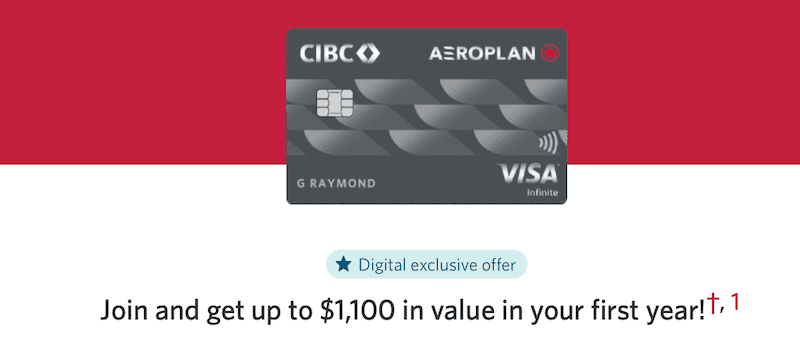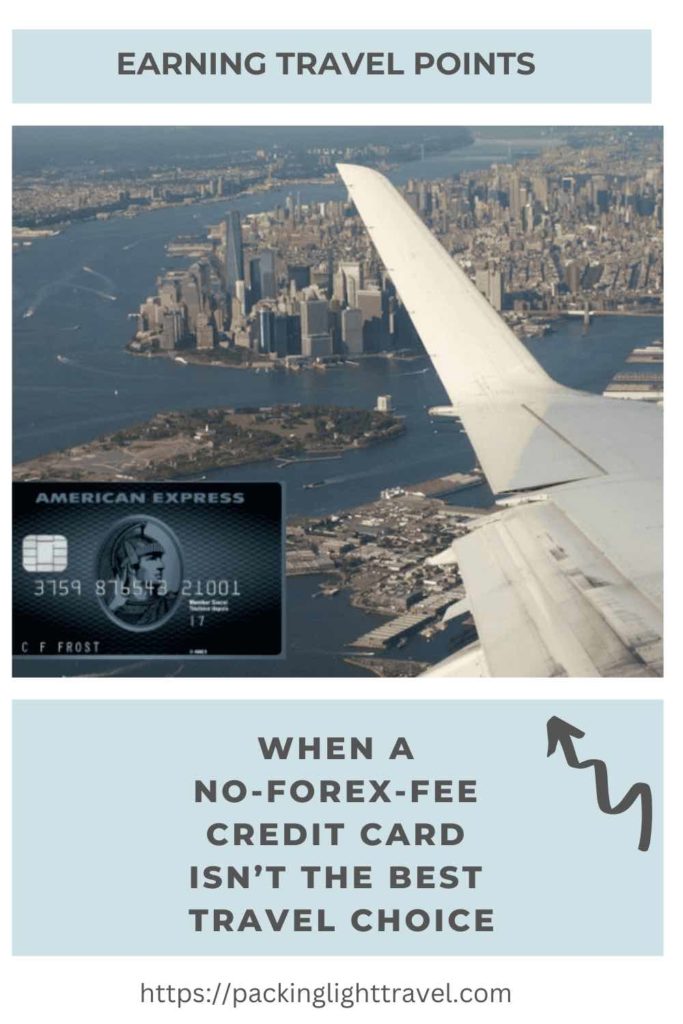Updated July 24, 2024
Ask the question in travel forums, “What is the best credit card for travelling abroad?” and answers invariably suggest those that don’t charge foreign transaction fees (FOREX or FX). Is a no-FOREX-fee credit card always the best choice for international travel? When might a no-FOREX-fee credit card NOT be the wisest choice as a travel credit card?
What is a no-FOREX-fee credit card?
FOREX (or FX) stands for foreign transaction. When purchases that pass through a foreign bank or are in a currency other than your home currency, they attract a FOREX fee charged by credit card issuers. They typically range from 1% to 3% of the transaction. In Canada, the fee is 2.5%.
It consists of two parts: a network or currency conversion fee charged by the network (e.g., Visa or MasterCard) and a bank fee charged by the respective financial institution.
 Image from quoteinspector.com
Image from quoteinspector.com
Some banks waive both components with a no-FOREX-fee credit card. These gems are more prevalent in the USA than in Canada.
What is the best credit card for international travel?
Ask this question in miles-and-points forums and the inevitable response is “Whichever card helps you meet the MSR.” The MSR, or Minimum Spend Requirement, is the spending threshold that needs to be met to unlock a sign-up bonus.
At any one time, there are multiple sign-up offers on a host of credit cards. Here’s an example of an offer on a CIBC Aeroplan Visa Infinite Card promotion beginning July 4, 2024.

- 10,000 Aeroplan points on the first purchase
- 20,000 Aeroplan points on a spend of $5,000 or more during the first four monthly statement periods
- 10,000 points anniversary bonus on at least $10,000 in net purchases during the first 12 monthly statements
- free first checked bag for two travellers for each round-trip flight with Air Canada
- annual fee rebate in the first year
Should your travel wallet include a no-FOREX-fee credit card?
Yes, when it’s to your advantage. There will be occasions, both at home and abroad, when saving the 2.5% FX fee is the best play.
For example, I use my no-FX-fee credit card for cross-border shopping for discounted audiobooks quoted in US funds. If I’m not working on a Minimum Spend Requirement, I’ll use it for subscriptions or other products quoted in US Dollars. I’ll also use it, on occasion, while travelling abroad.
But, is a no-FX-fee credit card always the best credit card to use when travelling abroad?
When might a no-FOREX-fee credit card not be the best choice as a travel card?
A no-FOREX-fee credit card isn’t the best choice for international travel when greater value can be extracted by using another credit card. While saving 2.5% on foreign purchases holds some appeal, it might not return the best value.
There are other considerations: earning on spending, and earning on sign-up bonuses. When earning on spending or earning on sign-up bonuses exceeds a 2.5% return, a no-FOREX-fee credit card might as well stay in your wallet.
Let’s use a sample trip budget of $10,000. How can you maximize the return on a $10,000 spend?
1. Points earned on trip expenses
Do the math to evaluate whether or not relying on a no-FX fee card is the best route. As a starting point, the 2.5% on $10,000 is $250. Using a no-FOREX-fee credit card exclusively represents a saving of $250.
 Image by Marco Verch, Creative Commons
Image by Marco Verch, Creative Commons
I’ll use two Canadian credit cards to crunch the numbers but the evaluation process remains the same.
For example, two no-FOREX-fee credit cards in Canada are issued by Scotiabank and earn Scene+ points: the Scotiabank Gold American Express Card and the Scotiabank Passport Visa Infinite.
When redeemed for travel, one Scene+ point has a fixed value of one cent.
How many Scene+ are earned on a $10,000 spend (in a foreign currency)? For the Scotiabank Gold American Express Card, it’s 10,000 Scene+ points on any expenses in a currency other than Canadian Dollars (CAD). These have a redemption value of $100 (for travel). When combined with your $250 saved on FX fees, your net gain is $350.
With the x2 points’ multiplier on groceries, dining, entertainment, and daily transit purchases on the Scotiabank Passport Visa Infinite, the base earnings of 10,000 points might increase to a maximum of 20,000. These have a redemption value of $200. Your net gain taking FOREX fees into consideration is $450.
2. Points earned by meeting Minimum Spend Requirements (MSR)
Let’s say you choose to invest that same $10,000 to meet the MSR on one or more credit cards. At any one time, you’d have a choice of several credit card offers, many with an enhanced sign-up bonus and a possible annual fee rebate in the first year. Most of them would far exceed $350/$450 in value.
Without taking into consideration benefits such as insurance and lounge access, here is an example of a credit card that would generate a much better return than a $350 or $450 value.

Take the CIBC promotional offer described above. Not taking the card’s points multipliers into consideration (x1.5 on gas, groceries, and at Air Canada), meeting the spending threshold of $10,00 on trip expenses would attract 50,000 Aeroplan points (40,000 points on sign-up bonuses and 10,000 points earned on the spend). According to Prince of Travel, an Aeroplan point is valued at 2.1 cents per point for a total value or $1,050. However, I’ve found that much greater value than 2.1 CPP (cents per point) can be extracted by redeeming points for flights in premium cabins.
3. Points’ multipliers in other reward currencies
How else can you maximize the number of points earned on trip expenses? Consider all loyalty programs within your miles-and-points portfolio to determine the best return.
This means looking at credit cards earning better multiplier bonuses in reward currencies offering greater value than Scene+.
Take the AMEX Cobalt card in Canada. It earns x5 on eats and drinks, x3 on eligible streaming services, and x2 on travel, including transit and taxis. For most people, expenses while travelling fall into the x5 and x2 categories. While the Scotiabank Passport Visa Infinite card earns x2 Scene+ on dining and groceries purchased in a foreign currency, the best value that can be extracted from a Scene+ point is a fixed value of one cent.
The Cobalt’s reward currency is Membership Rewards (MR). MR are a flexible rewards currency that can be converted to airline partners including Aeroplan and British Airways Avios. Prince of Travel values one MR at 2.1 cents. At this valuation, spending in the eats-and-drinks category abroad will result in up to a 10.5% return, or 8% after taking the 2.5% FOREX fee into consideration.
While American Express credit cards have a lower acceptance rate in some countries, this isn’t the case in others. Given that the Cobalt card occupies a permanent place in the wallets of many miles-and-points enthusiasts, Rewards Canada curates a crowdsourced list of confirmed multiplier locations around the globe.
The Cobalt is in my travel wallet and the first card I reach for when purchasing eats, drinks, and travel abroad.
What is the best credit card for travelling abroad?
If extracting value from credit card purchases is one of your goals, there may be better choices than focussing on the 2.5% savings on a no-FOREX-fee credit card.
A travel credit card with adequate insurance benefits is more useful if it:
- helps you meet a Minimum Spend Requirement for a compelling sign-up bonus
- has attractive points multipliers for foreign spending in travel-friendly categories (e.g., travel, dining, groceries, and entertainment)
- earns points in a reward currency and program capable of extracting maximum value for future travel
If you found this post helpful, please share it by selecting one or more social media buttons. How do you maximize travel expenses to fund future travel using miles and points? What are your favourite credit cards when travelling abroad? Please share your thoughts in the comments. Thank you.
Might you be interested in my other miles-and-points posts?
- How to use Scene+ points to reduce travel costs
- How to use CIBC Aventura points to reduce travel costs
- 9 Effective ways Meeting Minimum Spend Requirements for travel
- Polaris review: United Airlines’ lounge and in-flight experience
- Is the BMO Air Miles World Elite MasterCard a good deal?
- How to use TD Rewards points to reduce travel costs
Care to pin it for later?








Great post! Great discussion of no Forex cards. Most people I talk to aren’t aware of the extra 2.5% because it doesn’t create a separate entry on a credit card statement. I’ll be saving this post for future reference!
Jodie recently posted…Shoulder Season by Christina Clancy
Thanks for sharing valuable content, this is what I need to know. Now, I know what is a no-FOREX-fee credit card is and its benefits.